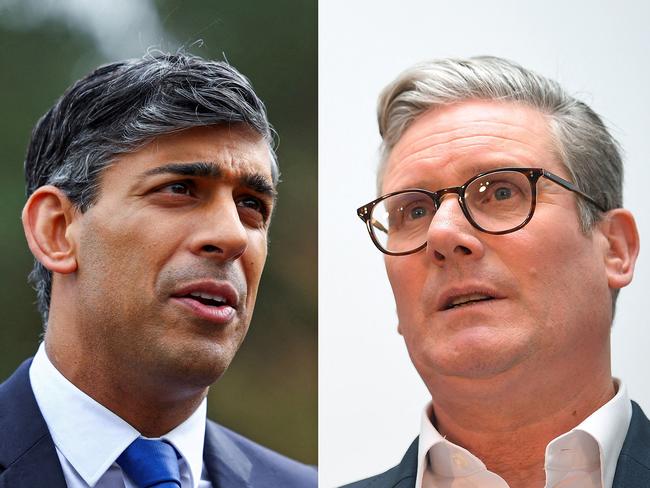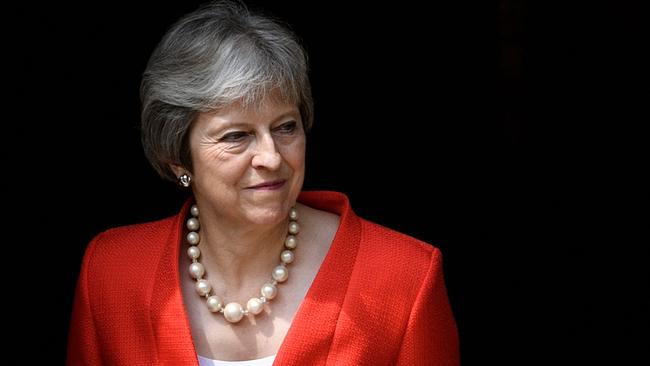The worst part about electing UK’s new PM Sir Keir Starmer
While Sir Keir Starmer and his Labour followers will celebrate, not everyone that voted for him will be dancing for joy, writes Julie Cross.
Opinion
Don't miss out on the headlines from Opinion. Followed categories will be added to My News.
Opinion: In a very small poll of my British friends and family, one described Sir Keir Starmer – the UK’s new Labour Prime Minister – as a “bit of a wet fish”.
Not the most resounding endorsement of a political leader that I have ever heard.
And, the thing is, they still voted for him.
In fact, the clear message from those I know in the UK was that no-one was very excited about Sir Keir, but they perhaps liked him a bit more than anyone else.

When it came to the incumbent Conservative Prime Minister Rishi Sunak, who was in the top job for less than two years, the overwhelming consensus was that he was “hopeless’, but they also felt he had been dealt a bad hand after inheriting the economic mess left by Liz Truss, perhaps the Tory’s most embarrassing Prime Minister in recent times (of which there are a few). Let’s not forget she lasted a mere 49 days.
Last minute entry, chief Brexiteer and leader of right wing start-up Reform, Nigel Farage, was “icky”, said one. One of his volunteers was caught in a TV sting for saying army recruits should carry out “target practice” by shooting at small boats bringing illegal migrants to the UK.
And, everyone I spoke to agreed the Liberal Democrats’ leader Ed Davey, was an “out and out buffoon”. For those who don’t know him, he spent the entire election campaign thinking he was in some kind of reality show, doing ridiculous photo opps, from bungee jumping to water slides and theme park rides.
Meanwhile, there were no thoughts on the new Scottish National Party leader, John Swinney, from my English-only poll, other than they hoped the SNP, which has been mired in a fundraising fraud scandal, lost seats.
So, while Sir Keir and his Labour followers will celebrate, not everyone that voted for him will be dancing for joy, unlike the last big Labour win in 1997, when Tony Blair practically tap danced down the road to D-Ream’s Things Can Only Get Better.
Since 2010, the Tories have presided over a chaotic period in Britain’s history, including Brexit, a botched Covid response, an explosion of illegal immigration, increased hospital waiting times, and five Prime Ministers.
While Sir Keir, may be a bit ‘blurgh’, let’s hope he’s got a bit of British bulldog in him to make the country better.
A REVOLVING DOOR OF UK CONSERVATIVE PARTY LEADERS
*By Justin Vallejo
The 14-year reign of the UK Conservative Party will be remembered more for its revolving door of Prime Ministers than its legislative successes.
Decades of British politics marked by the steady hands of its two longest-serving post-war leaders, the Iron Lady and Sir Tony, unravelled when Brexit set off an unending power struggle among the Tories.
David Cameron was the architect of his downfall with his unexpectedly successful referendum. Theresa May handled the fallout with as much grace as her dance moves. A head of lettuce famously survived longer than Liz Truss. Rishi Sunak just appeared in No 10 Downing Street without a single vote to his name. And BoJo was BoJo.
In total, five prime ministers lasting from as little to 50 days to six years served under the late Queen Elizabeth II and King Charles III since 2010.
That’s more than the four that held office in the previous three decades dating back to the election of Margaret Thatcher in 1979. She served 11 and half years before being replaced by John Major, who served for six and a half years. Labor’s Tony Blair took over for the following decade before he was replaced by Gordon Brown for another two and a half years.
Here’s the latest crop who came and went.
THERESA MAY
3 years and 11 days from 13 July 2016 to 24 July 2019

Theresa May was chosen as a safe pair of hands to steady the Brexit ship after the shock referendum. Instead, she was known for handling negotiations with European Union leaders with as much deft as her infamous dance moves.
Ms May’s Brexit deals were repeatedly rejected by parliament, and a snap election called in 2017 in an attempt to strengthen her position ended in the loss of her majority.
While consumed by leaving the European Union before the deadline, the UK descended into turmoil with several terrorist attacks in Westminster, the Manchester Arena and London Bridge.
After failing to deliver on the Brexit mandate, Ms May resigned with a teary farewell speech, saying it was the honour of her life but that it was time for someone else to lead the effort.
DAVID CAMERON
6 years and 64 days from 11 May 2010 to 13 July 2016
The self-described “heir to Blair” oversaw the establishment of a Labour-lite Tory party when he formed a coalition government with the Liberal Democrats in 2010.
The most recent of the 20 prime ministers churned out by Eaton College, Mr Cameron set the party on a course toward the left wing with “modernising” policies on public services, diversity, and immigration.
It opened a window on the Tories’ right flank that Nigel Farage and the UK Independence Party used to pressure a referendum to leave the European Union.
After spearheading the losing “Remain” campaign, Mr Cameron resigned rather than implement the Brexit he fought so hard to prevent.

Her three years at the helm of the party ending on July 24, 2019, was defined by a catalogue of failures, including her tough stance on Brexit, which cost her the support of party, by terrorist attacks in Westminster, London Bridge, and Manchester, the Grenfell Tower fire inquiry, and a public inquiry into the Salisbury poisonings – a botched assassination attempt to poison a former Russian military officer and double agent for the British intelligence agencies using chemical nerve agent Novichok, on March 4, 2018.
Mrs May blamed Russia for the attacks, with two Russian agents identified through CCTV to be members of the country’s military intelligence. The Kremlin denied responsibility.
She was also blamed for UK’s knife crime crisis after slashing police budgets.
After calling a snap election in June 2017, she was stripped of her working majority. She survived two votes of no confidence in December 2018 and January 2019, and resigned in July 2019.
BORIS JOHNSON
3 years and 44 days from 24 July 2019 to 6 September 2022

Boris Johnson was elevated to power and swept the 2019 general election with an 80-seat majority on the promise to “Get Brexit Done”.
But after leaving the European Union, the potential of his “levelled-up” Britain quickly faded as Johnson failed to implement the promises of Brexit that he had supported as a fervent “leave” campaigner.
His focus quickly shifted to Covid, Russia’s invasion of Ukraine, a cost-of-living crisis, and his personal defence of repeated ethics violations. Johnson survived one vote of no confidence, but lost the party’s support amid accusations he ignored sexual assault allegations against an MP.
He signed off declaring, “Hasta la vista, baby”.
While Mr Johnson was credited for “getting Brexit done”, overseeing the UK’s Covid-19 vaccination program, among the fastest in the world, joining the AUKUS security pact and being one of the first world leaders to offer humanitarian support to Ukraine following Russia’s invasion, his legacy as leader was dominated by scandal.
He suffered a backlash for hiring former Australian PM Tony Abbott as advisor to the Board of Trade over his views on “homosexuality, women and climate change” and triggered explosive rows over the cost of renovating his Downing Street flat.
But it was Mr Johnson’s hosting of the Covid bring-your-own-booze “partygate” scandal – which breached strict lockdown laws – that cost him the public’s confidence.
Both he and then chancellor Rishi Sunak were subsequently fined for breaking Covid regulations over the PM’s birthday gathering in the Cabinet Room in 2022.
His appointment of a deputy chief government whip amid claims he knew he had groped two men finally triggered a series of resignations and forced Mr Johnson to resign in July 2022.
LIZ TRUSS
50 days from 6 September 2022 to 25 October 2022

Liz Truss will go down in history as Britain’s shortest-serving prime minister after spending just 50 days in office.
Despite winning a gruelling weeks-long leadership battle, Ms Truss was quickly targeted for removal as senior members of her party resigned in protest of her economic libertarian policies.
Her ouster came after a disastrous mini-budge set off a massive economic crisis in the UK, which she later said was deliberately instigated by the Bank of England and the Office of Budget Responsibility.
Ms Truss may best be remembered as being photographed with the late Queen Elizabeth II days before she passed away. Ms Truss was the 15th Premier to serve with the Queen, dating back to Winston Churchill.
RISHI SUNAK
1 year and 253 days from 25 October 2022 to 4 July 2024 (projected)

After forcing the resignation of Ms Truss, Conservative Party MPs installed former Goldman Sachs banker Rishi Sunak without putting his leadership to the vote of members.
His tenure began with the fanfare of being the first Hindu to lead the country. It all but ended when he left the D-Day 80th anniversary commemorative service in Normandy early, leading to questions over whether he was proud of Britain’s history and values.
Mr Sunak oversaw the successful Windsor framework for Northern Ireland, one of the last sticking points in Brexit negotiations with the EU. But he was unable to reduce migration as his plan to process illegal immigrants in Rwanda was thwarted by endless litigation in the courts.
Mr Sunak’s surprise early election was widely seen as a hedge against the threat from Reform UK. But instead, it opened the door for a resurgent Nigel Farage to campaign against Mr Sunak’s failure to achieve the immigration control promised by Brexit.
More Coverage
Originally published as The worst part about electing UK’s new PM Sir Keir Starmer





